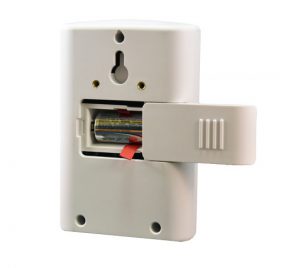Maintaining/Testing Your Low-Level CO Monitor
Battery Installation/Replacement
 Step 1: If the low-level CO monitor is wall mounted, simply pull up and out to remove it from the wall.
Step 1: If the low-level CO monitor is wall mounted, simply pull up and out to remove it from the wall.
Step 2: Slide the battery cover open as shown.
Step 3: Replace the battery with an approved CR123a 3-volt Lithium battery, making sure the battery terminals align properly with the low-level CO monitor terminals and push the battery into place.
Step 4: Slide the battery cover so that it is completely closed and return the low-level CO monitor to the original position. Warning: The cover will not close without a battery in place.
Step 5: Once the battery is connected, your low-level CO monitor will first display all the icons. The digital readout will then display a CAL which indicates it is calibrating to your indoor environment. Calibration will last approximately 5 minutes. During this time, do not move the monitor or place it near a source of CO. After calibration the monitor will go directly to Monitoring mode.
Step 6: Your advanced low-level CO monitor does not require a prolonged ‘power-up’ period. If you have followed all of the above steps correctly, your unit will begin monitoring for CO in 5 minutes. The word Monitoring on the display is your assurance that your unit is receiving power. If there are problems with the unit, the digital display will flash Err.
Step 7: Test the unit by pressing the Test/Reset button briefly to confirm that the low-level CO monitor is operating properly. The low-level CO monitor should sound as soon as the button is pressed, indicating that the horn is working and the battery is providing power to the unit. Release the test/reset button to silence the horn. The horn and battery should be tested on a monthly basis.
Warning: Prolonged exposure to the horn in close proximity will damage your hearing.
When there is no battery in place, the battery cover will not slide closed to remind you to replace the battery. Under normal operating conditions, the battery should last one year. The battery life in full alarm mode is 7 days. The low-level CO monitor will not protect against the risk of CO poisoning when the battery has drained.
Warning: Constant exposure to extreme high or low temperatures may reduce battery life.
Maintenance
Your low-level CO monitor will alert you to potentially hazardous CO concentrations in your home when maintained properly. To maintain your low-level CO monitor in proper working order, and to ensure that your sensor will maintain its 5-7 year life, it is recommended that you:
- Test your low-level CO monitor at least once per month
- Keep the low-level CO monitor free of dust by gently vacuuming the case with a soft brush attachment once per month
- Never use cleaning solutions on your low-level CO monitor. Simply wipe with a slightly damp cloth
- Do not paint the low-level CO monitor
- Do not spray aerosols on or near the low-level CO monitor.
- Move the low-level CO monitor to a safe location and store in a plastic bag before painting, wall papering, using or performing any other activities that use materials that emit strong fumes. Remember to remove it from the bag and replace the low-level CO monitor when these activities are finished.
Test/Sniffer Mode
CAUTION: All sensor testing should only be performed by a responsible adult. This test should be performed at least once a year, but not more often than once a month. Excessive testing will cause the battery life to be shortened.
Note: If you are unable to, or do not want to perform this test yourself, ask your installing professional about performing the annual testing for you.
 FOLLOW THESE STEPS TO TEST YOUR NSI 6000 MONITOR:
FOLLOW THESE STEPS TO TEST YOUR NSI 6000 MONITOR:
Step 1: Hold the Test/Reset button down for ten seconds or more, then release the button. The Spray Can Icon should be visible and the green LED will flash once per second. This indicates that the low-level CO monitor is now monitoring continuously for CO and may be tested using a
known source of CO.
Step 2: Light a cigarette or an incense stick using a match or lighter. Extinguish the lighter, or put out the match and place it into a dish of water.
Step 3: Hold the burning cigarette or incense stick 8-10 inches away from the low-level CO monitor, so that the smoke moves towards the slots above and below the LCD display in the front of the low-level CO monitor. The display will instantaneously indicate the amount of CO in the smoke. An increase in the CO level on the digital display will indicate that the sensor and electronics are working properly. Placing the monitor in a plastic bag filled with smoke will produce a more immediate response.
Step 4: Put out the cigarette or incense stick by placing it into a dish of water. Ensure that all flames have been extinguished.
Step 5: The spray can icon will disappear after four minutes, and the low-level CO monitor will then be in normal monitoring mode and the memory will reset to 0.
Note: If the spray can icon is flashing press the test/reset button once to return to ‘sensor testing’ mode.
